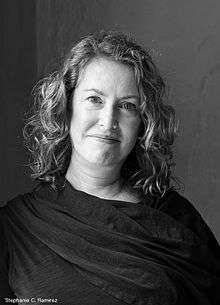Greta Pratt
Greta Pratt is an American photographer whose primary interests are American identity, history and myth. She is the author of two books of photographs, Using History (Steidl, 2005) and In Search of the Corn Queen (Smithsonian American Art Museum, 1994). Pratt's work is represented in major public and private collections, including the Smithsonian American Art Museum: Smithsonian Institution, The Museum of Fine Arts, Houston, Museum of Contemporary Photography, Portland (Oregon) Art Museum, and Minneapolis Institute of Art. Pratt served as photography bureau chief of Reuters International in New York City. Her photographs have been featured in Art in America, The New York Times Magazine and The New Yorker.[1]
Greta Pratt | |
|---|---|
 | |
| Born | 1960 |
| Nationality | American |
| Known for | Photography |
Career
Pratt has made a practice of documenting staged American history.[2] Her series Nineteen Lincolns celebrates one of the most iconic elements of the bedrock of American history and puts a quirky modern twist on it.[3] Nineteen Lincolns has been on view in solo and group shows across the country since 2007.[4] Her book Using History is an accurate depiction of her photographic universe, which is the intersection where American past meets American present. Pratt often uses clever juxtapositions of photos to tell her tale of how Americans incorporate their country's past to explain their attitudes to the present.[5]
Author Howard Zinn (People's History of the United States) says of Pratt's Using History, "Greta Pratt's extraordinary photographs give us glimpses of people and places that stimulate us to think about our history, not only of the great American West, but of the nation itself. Her point of view is delightfully antic and provocative. We want not only to enjoy the moment of our viewing, but also to study and ponder each photograph, challenged to find its larger meaning."[6]
Pratt's work has a clear connection with that of Martin Parr, both using hyper-saturated color to slyly capture the peculiarities of how everyday people represent themselves and their roots.[7]
Education
Pratt received her BFA in photography from the University of Minnesota and her MFA in from the State University of New York at New Paltz.
Books
- In Search of the Corn Queen (Smithsonian National Museum of American Art, 1994)
- Using History (Göttingen, Germany: Steidl, 2005.)
Quotes about Pratt's work
“…Everyone is trying to connect to the past but the past is always fiction. How history is told reveals much more about the people and time period that are telling it than about history itself.”[8] “This book is a collection of photographs about history perceived, about how we look at ourselves and others, about how we recreate and reaffirm the American experience, about how we continue to live with, to rationalize, and to atone for the lingering spirit of place….Pratt's photographs help create an understanding of a special form of vernacular storytelling, of acting out and dressing up the past. History as we remember it emerges from her photographs. Perhaps it could more correctly be labeled history as we want it to be remembered or, even better, as we re-create and relive it. As the American novelist Willa Cather reminds us, "Memory is better than reality."[9] “What Pratt catches here is not merely anachronism or irony…What you see here is the attempt by ordinary people – nonhistorians, that is – to capture history in a form that makes it locally communally tangible – history as shared terrain…There is an idea in most of these faces, though. The idea is continuity with forebears, with first principles, with a larger conception of the time horizon than everyday life usually affords."[10]
References
- "Greta Pratt: Using History | Museum of Contemporary Photography". Mocp.org. October 14, 2006. Retrieved December 8, 2013.
- John Leland. "Looking Like Lincoln". The New York Times. Retrieved December 8, 2013.
- Coppelman, Alyssa (November 9, 2012). "Abraham Lincoln impersonators pose for photographer Greta Pratt (PHOTOS)". Slate. Retrieved December 8, 2013.
- "CV". Greta Pratt. Archived from the original on December 3, 2013. Retrieved December 8, 2013.
- "Yahoo Groups". Yahoo!. Retrieved December 8, 2013.
- Greta Pratt. "Greta Pratt: Using History by Greta Pratt — Reviews, Discussion, Bookclubs, Lists". Goodreads.com. Retrieved December 8, 2013.
- http://2point8.whileseated.org/2007/01/03/greta-pratt-at-massmoca-and-atlanta-contemporary/
- "Greta Pratt: Taking Liberties " Candela Books + Gallery – Copyright 2012". Candelabooks.com. Retrieved December 8, 2013.
- Strickland, Rennard (2005). Using History, Public History, Vernacular Storytelling, and the Search for Self (Gottingen, Germany: Steidl.) ISBN 3865211291.
- Klinkenborg, Verlyn, History Matters, Mother Jones, Sept. 1999